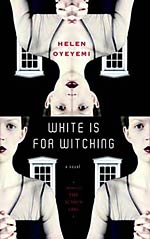
![]() krizzaro
krizzaro
5/19/2013
![]()
I am not into literary novels. For that reason alone, I probably should have avoided this book. "White is for Witching" is a very literary read, which translates into beautifully written but meandering, lacking in plot, and full of characters who aren't necessarily interesting or sympathetic. In fact, the most sympathetic characters are the minor characters.
The story (such as it is) follows Miri and her twin brother, Elliot, who are mourning after the death of their mother, Lily. Miri, who had pica to begin with, totally loses it after her mother's death and basically starves herself stupid. Very stupid. Not stupid enough to keep her out of Cambridge (?!?!), but stupid nonetheless. I suppose the book could be seen as chronicle of a mentally unbalanced woman killing herself through starvation and dragging loved ones down with her. It's not a very pleasant arc, and the inciting incident isn't quite satisfactory, but again, it's literary fiction. Things don't apparently have to make sense here. They often don't.
A folk tale appears many times in the story and I suspect WifW is supposed to be a re-imagining of the folk tale, but it doesn't work as that for me quite. In the folk tale a soucouyant is stealing the life force of young people. In the end, a brave girl banishes the soucouyant by rubbing salt and pepper on her skin (which she steps out of at night like a day dress). In WifW it's never even clear who the soucouyant is, which is a point even made in one of the chapter titles. In my reading the house (or the goodlady, who I think is the soul of the house) is the most likely candidate, though Miri is certainly also a candidate. Ore (who tells the story) makes a comment about her story mostly being about the end of the soucouyant. I suppose this could also be a story about the beginning of the soucouyant, though even there it's not quite right because the house starts collecting people long before Miri's around. It's not really clear why, or at what point the house changes from a benign run-of-the-mill house to a rather more sinister eat 'em up house, but there it is: we're dealing with the end of the soucouyant, not the beginning.
I also wasn't pleased with the dangling threads all through the book. Yes, I know it's far more realistic to have things that are never resolved, but in a book I don't expect half the book to be scenes that deal with something or someone that is so peripheral to the plot they might as well not be there. There most glaring to me were the multitude of subplots revolving around immigrants. The Silver/Dufresne family members are very WASP-ish and yet surrounded by immigrants, both legal and illegal, from all corners. The Silvers are very sympathetic toward immigrants, but the house they live in isn't. In fact, the house works hard to get rid of everyone except the Silver women, apparently seeing even brothers and husbands in the same light as the Kosovan refugees are seen by society at large. I wonder if the author was trying for an allegory here, but it's not one that works for me.
I don't know. It's a book that I think is trying to get me to think about it, but the characters and plot aren't compelling enough for me to really invest in.
http://librarycreature.blogspot.com.au/2013/05/white-is-for-witching.html